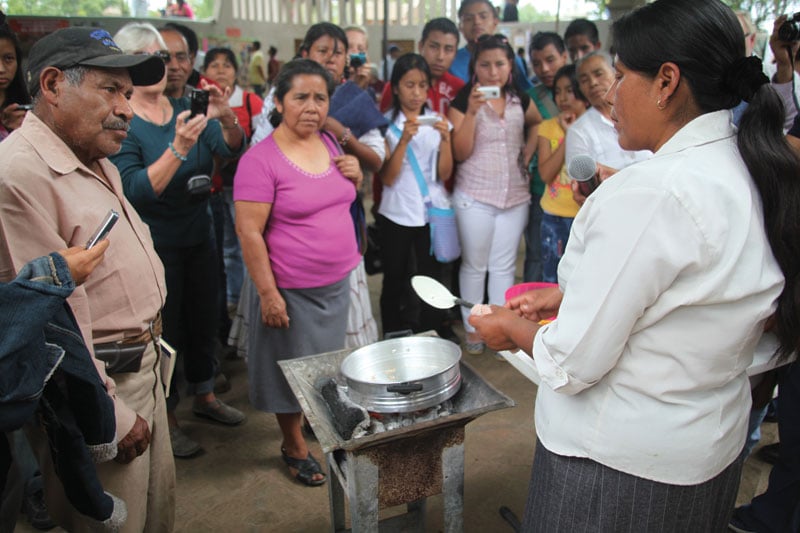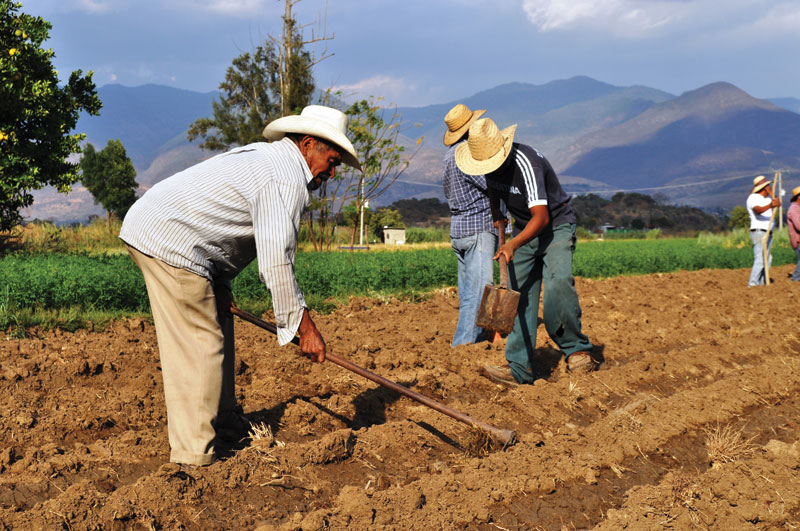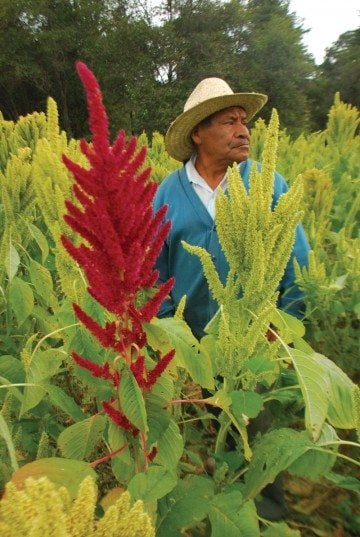
The Seeds That Time Forgot
A version of this story ran in the April 2013 issue.
Every morning, while her girls are still in bed, Irma Rosales makes tortillas for breakfast. She prepares the masa, pats it into little cakes, places them on a flat pan over a charcoal grill.
It’s a scene that’s been repeated in millions of households for hundreds of years, all across Mexico and Central America. But look closely at the tortillas on Irma’s comal and you’ll see something new: little white seeds. They’re amaranth, a crop native to the central valley of Oaxaca, Mexico, where Irma lives. Once, amaranth was a staple of Mesoamerican civilization. Now a Oaxacan nonprofit is trying to bring it back.
The organization is called Puente a la Salud, or Bridge to Health. Irma went to one of its workshops after a doctor diagnosed her daughter Ashly with chronic malnutrition. The doctor was a young man from the city, just out of medical school, doing his nationally mandated year of service in Mazaltepec, Irma’s small town.
“She’s underweight,” he said. “Your daughter is showing symptoms of chronic malnutrition.”
Irma listened as the doctor rattled off the signs: listlessness, depression. And if it wasn’t corrected, long-term brain damage. That hit hard.
Her family wasn’t wealthy, but Irma had thought her girls were okay. Like many people in Oaxaca State—one of Mexico’s poorest—she and her husband are subsistence corn farmers. They eat a typical rural Mexican diet of corn and beans. They are well-off enough to have a chicken, so they have eggs. Every now and then they even have meat.
Everything Irma had done, she had done to make life better for Ashly and her other three children. Like many Oaxacans, she had made a long and difficult illegal journey to the U.S. in hopes of making money to send home. She’d spent five years in Los Angeles with her husband, making jeans in a clothing factory for crappy pay. As often as she could, Irma talked on the phone to her daughter back in Mazaltepec with her husband’s family. Every time they talked, Ashly cried. She’d say, “Mama, when are you coming back?”
Eventually Irma and her husband had enough. The job wasn’t worth splitting the family. They returned home to Ashly and malnutrition.
As she left the clinic where her daughter was diagnosed, Irma saw a flyer for Puente a la Salud, inviting her to a workshop about a grain called amaranth. She decided to give it a shot.

Today, amaranth is rare and expensive, the sort of thing one buys in small bags at American natural-foods stores. Most Mexicans no longer eat it. But before the arrival of the Spanish in the 16th century, amaranth was eaten throughout the highlands of central Mexico and south into the high valleys of Oaxaca State.
Amaranth’s leaves are edible and full of vitamins. The combination of corn, beans and amaranth, whose grain-like seeds can be ground into flour, provides a complete protein, meaning it delivers all the amino acids the body can’t make for itself. The combination is as nutritionally complete as meat.
In the Aztec culture—unfortunately for the history of the Mexican diet—amaranth also had religious significance. It was a favorite food of Huitzilopochtli, the hummingbird-visaged God of War who, legend had it, led the Aztecs out of the country’s northern wastelands to become lords of central Mexico. Amaranth flowers are bright and sweet; hummingbirds love them. Huitzilopochtli, like all the gods of old Mexico, also loved the taste of human blood. A regular diet of sacrifices sustained him and kept the world from falling into darkness.
Every year during Huitzilopochtli’s sacred month, which corresponds roughly with December, Aztec families built little statues of the god in their homes out of puffed amaranth and honey. According to some accounts, they also included blood from human sacrifices. At the end of the month, the statue was carved up and eaten. The people would take the god into them, like Catholics with the host.
To arriving Spanish priests, the practice looked like intolerable paganism. And while not every Mexican used amaranth this way, the Spanish took no chances. Everywhere they went in Mexico, the Spanish tried to eradicate worship of the old gods. Because the amaranth service seemed like a demon mass—and because the Spanish god preferred wheat—the priests did everything possible to end the cultivation and consumption of amaranth.
It’s not clear if anyone missed it. Today, subsistence farms across the country that once grew corn, beans and amaranth now grow only corn and beans.
Amaranth was all but forgotten, surviving only in the highest, most isolated mountain valleys, places the Spanish language and the Catholic faith never penetrated.
The religious purge of amaranth succeeded, but the priests and farmers who banished it wrecked the rural Mexican diet along the way. Without amaranth, it was no longer possible for farming families—too poor to own animals—to get all the protein they needed.

The Texas woman who made it her goal to reintroduce amaranth to rural Oaxaca stumbled on the crop almost by accident.
Katherine Lorenz was 23 when she came to Oaxaca State, in southern Mexico. Austin-born and raised, Lorenz was Texas royalty, the granddaughter of George Mitchell, planner of The Woodlands and inventor of fracking. In March 2003 Lorenz went to Oaxaca with Amigos de las Americas, an international nonprofit that sends university and high school students to Latin America on a service program. Lorenz went into the countryside to build cookstoves.
Oaxaca State is a place where it is possible for aid workers to live in the First World while commuting daily to the Third. Oaxaca City is a posh vacation and retirement destination, a UNESCO World Heritage Site filled with art galleries and expensive restaurants. It is a city devoted almost entirely to the needs of tourists.
Outside the city, though, life goes on much as it has since before the Spanish conquest. In many communities people still speak traditional languages as a matter of course; it’s not uncommon to meet old people and children who speak Spanish poorly or not at all. Many towns survive largely on subsistence farming.
Working in Oaxaca, Lorenz gradually came to understand that many of the children she interacted with on a daily basis were malnourished. Few kids in the campo were outright starving, but if you looked closely you could see that something was off. Their eyes were dull, their hair a little too wispy. Children she thought were 5 or 6 turned out to be 9 or 10.
It wasn’t that they weren’t getting enough calories; it was that they were living on a diet of primarily corn and beans, and they weren’t getting the full complement of nutrients they needed to grow. Think of a malnourished child as a skyscraper under construction. There isn’t any steel for the girders. There isn’t enough cement. There’s no copper wire for the electrical systems, no pipe for the plumbing. And yet the body forges upward, scrounging what it can.
Lorenz had studied nutrition in college; she knew enough to realize that early-childhood malnutrition is serious. If a child suffers chronic malnutrition under the age of 5, brain development may be irreversibly stunted, putting children at risk for other problems. According to the United Nations Development Program, during Lorenz’s time in Oaxaca more than half the children in the countryside suffered from chronic malnutrition.
Looking to do something about it, Lorenz met Kate Seely, an American from Vermont. Seely, too, was concerned with malnutrition in the campo—a whole range of birth defects could be prevented if only local mothers could get enough folate. An organic farmer friend back in Vermont suggested amaranth, which has plenty.
Seely and Lorenz looked into amaranth and liked what they saw. It seemed like the perfect crop. It wasn’t just folate and protein; amaranth is a nutritional powerhouse, and the leaves can be eaten as green vegetables. As luck would have it, Seely had worked with a small mill in Oaxaca that processed amaranth seeds, so supply wouldn’t be an issue. With a $20,000 loan from Lorenz’s mother, the two founded Puente a la Salud to try to reacquaint rural Oaxacans with amaranth.
At the time, Lorenz said, she found romance in the idea of helping restore a native crop that had been all but destroyed.
“A lot of the intrigue to me was that I could say, ‘I’m foreign, but this grain has been here forever, and it’s a part of your history and culture,’” Lorenz told me. “I thought people would really like that.”

She was wrong.
Seely and Lorenz weren’t the first to hit on amaranth as a possible solution to the endemic malnutrition of the campos. As a native crop suppressed by the Spanish, amaranth had a certain political appeal to patriotic Mexicans. The famed Mexican chemist Alfredo Sanchez Marroquin had devoted much of the 1970s to recovering and restoring native Mexican crops. His disciples wandered the country, trekking into isolated pueblos where people still grew amaranth, gathering seed stock.
But early reintroduction efforts focused mostly on agribusinesses or welfare. No one in southern Mexico was trying to reintroduce amaranth as a staple crop that people actually grow and eat.
After founding Puente, Lorenz and Seely started hosting workshops in the small communities of rural Oaxaca State. The workshops were often organized by local doctors. In front of mostly female audiences, Lorenz and Seely would demonstrate cooking with amaranth, showing women how to make traditional corn-based foods like tortillas and atole with added amaranth. They gave out free amaranth seed.
“We thought it was going to be about nutrition,” Lorenz told me. “We thought we were going to explain the nutritional benefits to people, and then show them how to cook with it, and they’d like it so much they’d start growing it.”
She laughed. “I learned you can’t just bulldoze your way into someone else’s culture and expect them to change.”
It turned out that few of the traits that attracted Lorenz and Seely to amaranth had much influence on the Oaxacans. They’d try the amaranth, maybe like it enough to eat it on occasion, but they weren’t integrating the seeds into their diets.
And the Oaxacans didn’t much care about the grain’s indigenous heritage. Lorenz and Seely lectured their audiences about amaranth’s role in pagan ceremonies, about its importance as a tribute to the Aztecs, its role as a native staple.
“That had zero attraction,” Lorenz said. “We had surveys at the end to see what people had learned, and that one didn’t even register. People just didn’t give a damn.”
It may be that “tradition” and “natural” are resonant only to people who are not already up to their eyeballs in tradition and nature. Lorenz was initially surprised by the disinterest. Then she was surprised she had been surprised.
“Most people in the campo want the new best thing. They want the new iPhone. Eating what your great-great-grandparents ate was not attractive.”
What turned out to work best was simple self-interest. The Oaxacans who came through Puente were mostly farmers and the children of farmers. When Lorenz and Seely gave them seeds and presented amaranth not as a heritage grain or a nutritional supplement but as something they could sell for money, suddenly people were interested.
Then came the happy accident. A few years into the program, the Kellogg Company introduced an amaranth cereal that was widely sold throughout Mexico. Amaranth came to be seen as a luxury food. It had cachet. Within two years the market price for a kilo of amaranth tripled. Farmers took notice and began planting amaranth. And once there was amaranth growing in their own fields, farmers were more likely to eat it.
Today the walls of Irma’s mud-brick house are covered in Puente-printed amaranth posters advising Un Puño Cada Día: one handful a day. After her workshop, Irma joined a Puente program called Summer of Health, in which she learned new ways to cook with amaranth. She also learned to incorporate vegetables like carrots and beets into her daily recipes.
She watched her daughter Ashly start to put on weight.
On a warm day in January, Puente volunteers prepared an organic garden for one of her neighbors. Irma’s daughters ran around with a couple of girls from the neighborhood, carrying stalks of carrizo cane and occasionally whacking each other with them. They had big smiles on their faces; their eyes were bright.
I sat with Irma in a field of alfalfa and watched the girls play. When I asked Irma about amaranth, she didn’t say anything about ancestors, or Aztecs, or food sovereignty. She just sighed and said, “Thank God my daughter is healthy.”

